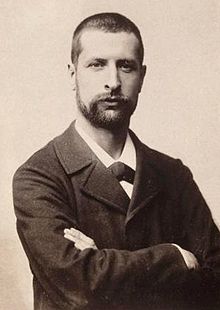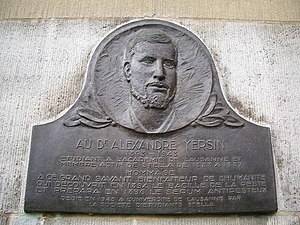Alexandre Émile Jean Yersin
Alexandre Émile Jean Yersin , also (internationally) Alexandre John Emile Yersin (born September 22, 1863 in Lavaux near Aubonne , Switzerland ; † February 28, 1943 in Nha Trang , Annam , today Vietnam ), was a Swiss - French doctor and bacteriologist who discovered the causative agent of the plague , Yersinia pestis . It was the entire honor bacteria - genus Yersinia called.
Life
Yersin grew up in Morges on Lake Geneva . His father died three weeks before Alexandre was born. After the death of her husband, his mother opened a boarding school for girls in Morges and raised the son and his two older siblings alone. The 8-year-old's natural scientific research spirit was sparked when he discovered his father's insect collection in the attic and was increasingly actively involved in it.
After studying in Lausanne and Marburg , Yersin went to Paris and worked at the Pasteur Institute , among other things, together with Émile Roux on diphtheria , where they demonstrated diphtheria toxin . He received his doctorate in 1888 on experimental tuberculosis and attended Robert Koch's bacteriological course in Berlin . In order to be able to practice the medical profession in France, he became a French citizen .
In Indochina he worked as a ship's doctor from 1890 and undertook research trips there. When the wave of plague spreading from Mongolia reached the southern Chinese coast in 1894 , the French government and the Pasteur Institute sent him to Hong Kong to find the hitherto unknown cause of the disease. At the same time and with the same goal, a Japanese research group was working there under the direction of Shibasaburo Kitasato . Although Yersin was poorly equipped and was hindered in his work by the English colonial authorities, he succeeded on June 20, 1894 in isolating the pathogen from infected lymph nodes ( bubons ) from plague deaths and transmitting the disease to mice and guinea pigs . The fact that, unlike Kitasato's group, he did not have an incubator and had to grow his bacterial cultures in a bamboo hut at normal air temperature was a fortunate circumstance, because under laboratory conditions Yersinia pestis reproduces better at temperatures that are lower than the human body temperature.
Yersin also demonstrated experimentally that the plague pathogen he identified was also responsible for the massive rat deaths that occurred at the same time in Hong Kong. The only thing missing to fully elucidate the essential links in the chain of infection of this zoonosis was that the plague epidemics "jump over" from animals to humans through the rat flea bite . Masanori Ogata and Paul-Louis Simond discovered this in Bombay three years later . The pathogen that Kitasato isolated in Hong Kong and described as the cause of the plague later turned out to be an accidental accompanying germ of the disease, but Kitasato was long considered to be the (co-) discoverer of the plague pathogen. In 1970 the bacterium was given its current name, in memory of Yersin's achievements.
In 1895 Yersin was in Paris and worked on the development of a healing serum , which he then used in the Far East in the treatment of plague sufferers, but which had no effect when the plague occurred in Bombay in 1897. In the following years he worked on behalf of the colonial administration with agricultural projects in Indochina, including the planting of Hevea brasiliensis for the production of rubber and of Cinchona ledgeriana , a cinchona bark tree from whose bark the anti- malarial agent quinine is made. In 1902 he became director of the newly established school for medical auxiliaries in Hanoi for two years , which later became the medical college. From 1904 to 1924 he headed the Pasteur Institute's branches in Saigon and Nha Trang . In 1934 he was appointed to the scientific advisory board of the institute in Paris and was appointed honorary director and chairman of the institute's annual general assembly. In 1916 he was accepted as a corresponding member of the Académie des sciences .
Yersin's memory is held in high esteem in Nha Trang. There is a Yersin Museum in the Pasteur Institute and his monument on the waterfront. The people of the city thank him in particular for the fact that Yersin managed to predict typhoons, which saved the lives of many fishermen.
The collar jay ( Garrulax yersini , syn. Trochalopteron yersini ), a rare species of songbirds of the family Leiothrichidae found in Vietnam , is also named after Yersin.
The Latin epithet of the common loach species Schistura yersini , a freshwater fish that is also found in Vietnam, where it was first collected by researchers in Đà Lạt , refers to Alexandre Yersin.
literature
- Rosemarie Dilg-Frank: Alexandre Yersin (1863–1943) as a medical student in Marburg . In: alma mater philippina , winter semester 1978/79, pp. 19–23.
- Stefan Winkle: Scourges of humanity. Cultural history of epidemics . Artemis and Winkler, Düsseldorf / Zurich 1997, ISBN 3-538-07049-0
-
Patrick Deville : Peste et Choléra . Novel. Seuil, Paris 2012, ISBN 978-2-02-107720-9
- German translation: plague and cholera . Translated from the French by Holger Fock and Sabine Müller. Bilger, Zurich 2013, ISBN 978-3-03762-037-3 (biographical novel)
- Barbara I. Tshisuaka: Yersin, Alexandre John Emile. In: Werner E. Gerabek , Bernhard D. Haage, Gundolf Keil , Wolfgang Wegner (eds.): Enzyklopädie Medizingeschichte. De Gruyter, Berlin / New York 2005, ISBN 3-11-015714-4 , p. 1512.
Web links
- Biography . Archives de l'Institut Pasteur (French)
- Mariama Kaba: Yersin, Alexandre. In: Historical Lexicon of Switzerland .
- Literature by and about Alexandre Émile Jean Yersin in the catalog of the German National Library
- Daniela Wakonigg: September 22nd, 1863 - The birthday of Alexandre Yersin WDR ZeitZeichen September 22nd, 2013. (Podcast)
Individual evidence
- ^ Service des Archives de l'Institut Pasteur: Alexandre Yersin (1863-1943) .
- ↑ Alexandre Yersin, discoverer of the plague pathogen , biographical essay PDF by Peter Jaeggi in SWR2 from June 16, 2014, accessed June 19, 2014
- ^ DJ Bibel, TH Chen: Diagnosis of plaque: an analysis of the Yersin-Kitasato controversy. In: Bacteriological reviews. Volume 40, No. 3, September 1976, pp. 633-651, ISSN 0005-3678 . PMID 10879 . PMC 413974 (free full text). (Review).
- ^ List of former members since 1666: Letter Y. Académie des sciences, accessed on March 16, 2020 (French).
- ↑ see under Schistura ( Memento from March 3, 2016 in the Internet Archive ).
| personal data | |
|---|---|
| SURNAME | Yersin, Alexandre Émile Jean |
| BRIEF DESCRIPTION | Swiss-French doctor and bacteriologist |
| DATE OF BIRTH | September 22, 1863 |
| PLACE OF BIRTH | Aubonne , Switzerland |
| DATE OF DEATH | February 28, 1943 |
| Place of death | Nha Trang , Vietnam |


